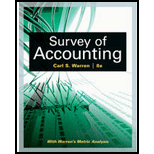
Introduction:
Bank reconciliation is a process of matching items and amounts in cash balances reported on company's ledger with the balance of cash account reported in the bank statement. The cash balance adjusted after reconciliation is recorded in the
Bank reconciliation is divided into two parts where in part one bank section begins with cash balance as per bank statement and ends with the adjusted balance, while in second part company section begins with cash balance as per company records and ends with the adjusted balance.
To choose:
The correct option that would reconcile the bank account of the company.
Trending nowThis is a popular solution!

Chapter 5 Solutions
Bundle: Survey of Accounting, Loose-Leaf Version, 8th + CengageNOWv2, 1 term Printed Access Card
- I am searching for a clear explanation of this financial accounting problem with valid methods.arrow_forwardA $5,000 bond issued in 2020 pays $275 in interest each year. What is the current yield on the bond if it can be purchased for $4,200?arrow_forwardPlease help me solve this financial accounting question using the right financial principles.arrow_forward
- I need assistance with this financial accounting question using appropriate principles.arrow_forwardPlease explain the correct approach for solving this general accounting question.arrow_forwardPlease explain the solution to this general accounting problem using the correct accounting principles.arrow_forward
- Camden Electronics applies manufacturing overhead on the basis of direct labor-hours. At the beginning of the most recent year, the company based its predetermined overhead rate on total estimated overhead of $95,000. Actual manufacturing overhead for the year amounted to $97,200, and actual direct labor-hours were 9,400. The company's predetermined overhead rate for the year was $10 per direct labor-hour. The applied manufacturing overhead for the year was closest to _.arrow_forwardMorgan Industries assigned $375,000 standard direct materials cost to its output for the current period. The direct materials variances included a $12,500 unfavorable price variance and a $8,200 favorable quantity variance. What is the actual total direct materials cost for the current period? Correct answerarrow_forwardPlease provide the correct answer to this financial accounting problem using accurate calculations.arrow_forward
 Survey of Accounting (Accounting I)AccountingISBN:9781305961883Author:Carl WarrenPublisher:Cengage Learning
Survey of Accounting (Accounting I)AccountingISBN:9781305961883Author:Carl WarrenPublisher:Cengage Learning Financial AccountingAccountingISBN:9781337272124Author:Carl Warren, James M. Reeve, Jonathan DuchacPublisher:Cengage Learning
Financial AccountingAccountingISBN:9781337272124Author:Carl Warren, James M. Reeve, Jonathan DuchacPublisher:Cengage Learning College Accounting (Book Only): A Career ApproachAccountingISBN:9781337280570Author:Scott, Cathy J.Publisher:South-Western College Pub
College Accounting (Book Only): A Career ApproachAccountingISBN:9781337280570Author:Scott, Cathy J.Publisher:South-Western College Pub- Principles of Accounting Volume 1AccountingISBN:9781947172685Author:OpenStaxPublisher:OpenStax CollegeCentury 21 Accounting Multicolumn JournalAccountingISBN:9781337679503Author:GilbertsonPublisher:Cengage





